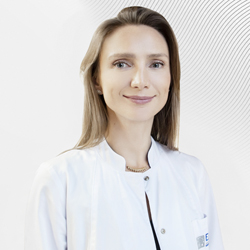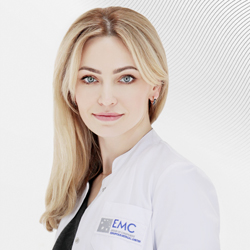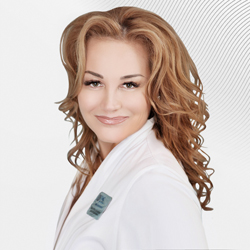One of the priorities of the EMC Gynaecology and Gynaecological Oncology Clinic is diagnosis and treatment of cysts and ovarian tumours (lumps), often diagnosed in women of reproductive age, and after the menopause.
Often the terms cyst, cystomas, and ovarian tumours, are practically synonymous to the clinician and signify the presence of abnormal lumps (growths) in the ovary. The fact is that international classifications have concepts of ADNEXAL MASS, OVARIAN MASS, and OVARIAN CYST, which are all interchangeable, and each cystic ovarian lump may be described by one of the three terms.
An ovarian tumour implies the presence of cysts containing a dense component. In itself, the cyst is a bubble on the surface or inside the ovary filled with liquid. Even for modern methods of introscopy (ultrasound, CT, MRI), and hence for the onco-gynaecologist, these lumps are distinguished only by the nature of the content.
There are many classifications in histology, size and functionality, but the classification according to the degree of malignancy is universal, and satisfies the information about the disease for both the doctor and the patient.
Cysts and ovarian tumours are divided into three types:
- Benign and cysts
- Borderline ovarian growths
- Malignant growths (tumours) of the ovaries
Benign ovarian (cysts) are more common in young women and may be associated with diseases such as endometriosis (when the cells of the endometrium, the inner layer of the wall of the uterus grow outside of this layer), and may also be a result of menstrual irregularities.
Borderline ovarian tumours are more common in women over the age of 30. Under the microscope, the cyst may be defined as malignant, but they have a clinical course more reminiscent as benign. In rare cases, borderline tumours cause the spread of metastases, but often provoke relapses (when later the tumour returns to the ovary or appears elsewhere), and in these cases, require repeated operations. Chemotherapy is not effective in this case.
Malignant tumours of the ovaries (ovarian cancer) occur in women after menopause in the majority of cases. Unfortunately, 80% of patients only visit the doctor when symptoms of the third or fourth stage of the disease appear. In these cases, the most radical surgery is performed to remove all of the tumour from the abdomen, and after surgery (and in some cases prior to surgery) undergo chemotherapy. Despite the late stage treatment, 30-40% of patients have the chance of a complete cure.
How do cysts (growths, tumours) of the ovaries appear?
Some women visit the gynaecologist with lower abdominal pain. Sometimes this pains is of cyclical nature, and in some cases it is continual. In some cases, cysts and ovarian growths are detected by chance during preventive ultrasound examinations.
What are tumour markers? What are they used for?
Tumour markers are specific substances in biological fluids of patients as a result of cancer cells. The most commonly studied tumour marker in the blood in ovarian neoplasms is CA-125. It is often defined upon detection of cysts or ovarian growths. Unfortunately, CA-125 has no specificity. It may increase several times in benign processes in the abdominal cavity (uterine myoma, endometriosis, benign ovarian cysts, colitis and others), while in half of women with malignant ovarian tumours in the early stages, the CA-125 level is normal. Therefore, the definition of CA-125 often is not used to resolve the question of malignancy of tumours prior to surgery, but in conjunction with ultrasound data, may in some cases be meaningful as a diagnostic indicator to the surgeon or gynaecologist.
Does the presence of cysts require their removal?
Only functional cysts (cysts that are formed as a result of the menstrual cycle and when there is no ovulation) require observation by a gynaecologist. Functional cysts should disappear after 1-2 menstrual cycles. If this does not happen, the cyst is not functional, but pathological.
Polycystic ovaries (many small cysts on the periphery of the ovary) may be normal or a sign of one of the components of polycystic ovaries syndrome. These small cysts in most cases do not require treatment unless they are combined with infertility or irregularities of the menstrual cycle.
Polycystic ovaries are in fact found in 15-20% of totally healthy women and do not require treatment. In other cases, they are clinically significant as polycystic ovarian syndrome (hyperandrogenism, disrupted menstrual cycle). All other cysts and ovarian growths are considered pathological and require surgical removal.
What is the purpose of the operation?
It is only possible to accurately identify a benign or malignant (border) cyst, after removal of the ovarian cyst or ovary with a cyst by operation. All methods of preoperative diagnosis (ultrasound, tumour markers, analysis of symptoms) are approximate and do not provide a 100% answer to the question of malignancy. Some cysts may also cause ovarian torsion, when the blood supply stops the ovary dies off, which is an indication for an emergency operation.Some cysts may spontaneously explode, sometimes causing significant bleeding (ovarian apoplexy), which usually also require emergency surgery.
Is it possible to save the ovary that has a cyst, or is its complete removal required?
It mainly depends on the nature of the cysts, the woman's age and other factors. Speaking of benign ovarian cysts (endometrioma, adenocystoma, folicular cyst, etc.), when they are not very large, the possibility of saving the ovary and removal of only the cyst with a capsule to avoid relapse is possible.
If during the operation, the cyst from the point of view of oncology looks suspicious, it is safer to remove the entire ovary along with the cyst by immersing it in a plastic bag directly into the abdomen, and then extract it. It is very important not to "break" the cyst in the stomach, i.e. that its content does not enter the abdomen of the patient, as it may cause problems in the future.
Your gynaecologist must warn you about the possibility of the need to remove the entire ovary with the cyst (tumour), and that this decision can be taken as a surgeon during the operation, although in most cases the ovary may be retained.
In some cases, it may be necessary to remove the cyst along with the ovary. In this case, the surgeon sends it for urgent histological examination, the results of which can help quickly decide on the necessary volume of surgical intervention during the operation.
Are there still chances for pregnancy and child birth if you remove one of the ovaries?
One ovary can fully perform its functions, including producing sex hormones, allowing a normal menstrual cycle, as well as monthly egg formation. If the fallopian tube is saved and the ovary is passable, the chance to get pregnant and bear a child is the same as for women with two ovaries.
How are the operations carried out?
If the cyst (growth) of the ovary is not too large, is less than 7-9 centimeters in diameter, and does not cause much suspicion for malignancy based on the results of the ultrasound, a minimally invasive procedure is performed: a laparoscopy.It is worth noting that the vast majority of ovarian cysts fall into this category, and are treated by laparoscopic surgery, which provides excellent cosmetic results, minimal blood loss during the operation and rapid recovery.If the cyst is too large and cannot be removed safely from the abdomen through small laparoscopic holes, then an abdominal operation is performed.
If the ultrasound or computed tomography (CT) or tumour markers of blood are substantially suspect that the growth is malignant, abdominal surgery is performed in this case. In the event of a number of atypical cysts and growths of the ovaries, laparoscopic surgery is expedient. In other cases, laparoscopy is used only to diagnose ovarian cancer tumours, and then the abdominal operation begins.
Is there non-surgical treatment of cysts (growths) of the ovaries?
Not counting functional cysts and polycystic ovaries, other types of cysts and growths are treated surgically. There is a misconception that some hormonal preparations promote resorption of cysts, but there is no evidence of the effectiveness of this method in medical literature.
In some cases, the cyst resolves itself (functional cyst), but this usually occurs spontaneously, and not because of the use of hormonal drugs. The use of hormonal (contraceptive) drugs are really only justified in one case: for prevention of the recurrence of functional and other benign ovarian cysts. Moreover, the use of hormonal contraceptives for 5 years or more (in total during the life of the woman) reduces the risk of ovarian cancer by 40%.
What doctor should be seen regarding ovarian cysts?
If an ultrasound shows ovarian cysts, you should consult a gynaecologist-surgeon, specializing in laparoscopic surgery. Even if the cyst is functional, the gynaecologist-endosurgeon will continue to monitor patients for several months until the cyst has dissolved on its own. If the cyst is atypical or there is suspiscion of the presence of a border or a malignant tumour, then you should ask the surgeon-oncologist to prescribe additional examinations and either carry out either laparoscopic or abdominal surgery.
EMC oncologist surgeons have applicable surgical training, much surgical experience in gynaecological oncology and related disciplines, state-of-the-art equipment, and most importantly, an understanding of the necessity of radical removal of the tumour during surgery.
The main task of the EMC Gynaecology and Gynaecological Oncology Clinic is to provide surgical and therapeutic care in gynaecology and gynaecological diseases in a short time, most effectively, safely and with minimal side effects. The work is formed in accordance with standards of evidence-based healthcare practiced in the USA and Western Europe.
The team of doctors of the department includes surgeons-gynaecological oncologists, surgeons-gynaecologists, and urogynaecologists, who have both years of practice in the best clinics in Russia, the USA, Europe and Israel, and powerful theoretical training, which is constantly being improved because the doctors participate in international congresses and conferences in their specialization.
The head of the department, Vladimir Nosov, is an experienced surgeon-oncogynaecologist and obstetrician-gynaecologist, board certified in the United States in obstetrics-gynaecology and gynaecological oncology, as well as a certified specialist in obstetrics-gynaecology and oncology in Russia.
EMC Clinic is one of the few clinics in Moscow, where the level of medical service delivery meets the corresponding international standards.

 Write to WhatsApp
Write to WhatsApp













